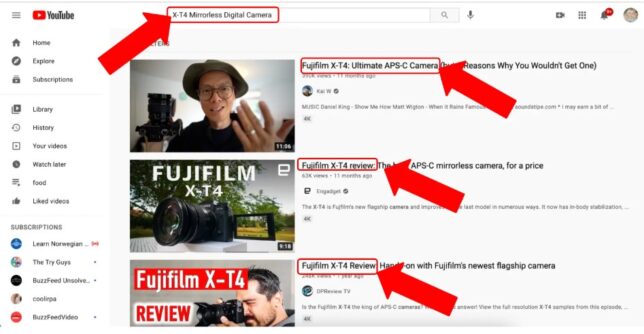
Is a classic sales letter or page better than a video sales letter (VSL)? Marketers have been asking that question and testing results for over a decade.
Most statistics reveal that video typically out-converts text because viewers don’t have to be as engaged as readers to be understood. Marketing strategies continue to evolve in the digital landscape, and one such shift involves transitioning from Text Sales Letters (TSLs)to Video Sales Letters (VSLs). This article will help you through this transformation to keep your business at the forefront of your niche and ahead of the competition.
Understanding Text Sales Letters and Video Sales Letters (VSL)
Text Sales Letters have long been a staple in direct sales marketing. They provide a narrative and follow a classic sales copy structure, like PAS (Problem-Agitate-Solution), AIDA (Attention, Interest, Desire, and Action), or one of the other acronym formulas. The sales letter aims to provide a prospect with information and emotional reasons to help them conclude to buy now.
The sales letter empathizes with a prospect by identifying pain points. It then guides the reader from pain to a logical solution and provides an instant call to action.
VSLs take the same basic structure as Text Sales Letters but present it in a dynamic, engaging video format. They have the advantage of combining visuals, audio, and storytelling to create an immersive experience for the viewer. Video allows for a more persuasive sales pitch.
The Anatomy of an Engaging VSL
Creating an engaging VSL involves understanding its essential elements and structure. VSL is more than just a video version of a text sales letter. It’s a tool designed to leverage the power of visual storytelling to make a compelling sales pitch.
4 Key Elements Make VSLs Stand Out
Four key elements that make VSLs stand out include:
- A compelling script
- High-quality visuals
- Professional voiceover
- A clear call-to-action (CTA).
The script should be persuasive and engaging, clearly explaining the product’s benefits and how it solves the viewer’s problem. Adding high-quality and relevant visuals help to illustrate the points made in the script. The voiceover should complement the brand. It must be professional and emotive, adding personality to the sales pitch. Lastly, the CTA should be clear and persuasive. Tell the viewer precisely what to click and where to go, such as “click the link below this video.”
Long-Tail Keywords and Their Importance in VSLs
Specific long-tail keywords are less competitive than general ones. They make ranking in search engine results easier. Including long-tail keywords in your VSL script helps SEO and ensures your content reaches the right audience.
But it’s not the words in the script that matter to SEO. It’s the content tags. Always add tags to your content using as much detailed identifying information as possible. Tags make your video searchable on YouTube for viewers looking for informational videos like yours. By incorporating long-tail keywords in tags, businesses can attract highly relevant traffic and increase the chances of conversion. For example, if a skincare company sells organic products, long-tail keywords like “best organic skincare routine” or “natural anti-aging solutions” can attract individuals specifically searching for those products.

Why Transform Text Sales Letters into VSLs?
The changing preferences of consumers drive the VSLs’ growth. Video content is responsible for 82% of all internet traffic. As a result, VSLs are more likely to hold a viewer’s attention, resulting in higher engagement and conversion rates. 96% of people online have viewed a video to learn more about a service or product before buying. It makes good business sense to convert winning sales letters into VSLs.
A Step-by-Step Guide to Turning Text Sales Letters into VSLs
- Review the Text Sales Letter – Analyze the existing text sales letter to identify its strengths and weaknesses. Edit the copy to read naturally.
- Identify Key Messages and Benefits – Determine the core messages, benefits, and values you want to convey. Highlight the unique selling points (USPs) and customer pain points.
- Craft a Compelling Script – Write a script that grabs the viewers’ attention from the beginning and keeps them engaged. Use persuasive language, storytelling techniques, and social proof to make the script more impactful.
- Create Visuals and Storyboard – Develop visuals that support the script and enhance the overall message. Storyboard the VSL to ensure a smooth flow of visuals and transitions.
- Record and Edit the VSL – Read it aloud multiple times as you edit. Use professional equipment to record and incorporate the audio narration into the visuals. Add appropriate visuals, audio, and text.
- Add Background Music and Sound Effects – Enhance the overall experience by adding suitable background music and sound effects that complement the message.
- Optimize for SEO – Incorporate relevant long-tail keywords in the tags, title, and script to improve search engine visibility and attract targeted traffic. While keywords can help improve search results, the quality of your content is the most important.
- Test and Optimize – Once you launch the VSL, monitor its performance. Analyze engagement metrics, conversion rates, and viewer feedback to identify areas for improvement, then make the necessary optimizations.
Are you in a hurry? Hire someone to turn your text sales letter into VSLs. Many copywriters and video production agencies specialize in creating VSLs. When hiring someone for this task, ensure they have experience in scriptwriting, video production, and storytelling techniques. Provide them with your text sales letter and any specific instructions or preferences you have. Collaborate closely with them to ensure the VSL effectively communicates your message and drives sales.
How to Create Effective VSLs for Small Businesses
Small businesses can leverage VSLs to communicate their value proposition and drive sales effectively. Try these tips:
- Know Your Target Audience – Know your prospects and customers. What keeps them up at night? What solutions do they want? Create a VSL that resonates with them.
- Keep it Concise – Small businesses should deliver concise messages in their VSLs. Avoid overwhelming viewers with excessive information.
- Highlight Unique Selling Points – Showcase your products or services’ unique features and benefits to differentiate yourself from competitors.
- Include a Strong Call-to-Action – Clearly state the desired action you want viewers to take at the end of the VSL. Make it easy for them to follow through.
- Optimize for Mobile – 70% of all video gets viewed on mobile devices. Ensure your VSL is optimized for mobile viewing to reach the most significant portion of your audience.
The Importance of Sales Letter Conversion in Ecommerce
In the competitive world of ecommerce, sales letter conversion plays a crucial role in driving revenue and growth. A well-optimized sales letter can significantly impact a business’s bottom line. By transforming text sales letters into VSLs, ecommerce businesses can enhance their conversion rates by reaching new customers that may otherwise not engage with a sales page.
Enhancing Ecommerce with VSLs
Implement the following tips and strategies to leverage VSLs to grow your business:
- Product Demonstrations – Use video content to demonstrate how products work and highlight their key features. This visual info helps potential customers better understand the product and its benefits.
- Customer Testimonials – Incorporate customer testimonials in VSLs to build trust and credibility. 2 out of 3 people say video testimonials influence purchasing decisions.
- Limited-time Offers – Offering limited-time discounts or promotions in the video creates a genuine sense of urgency that helps boost conversions.
- Interactive Elements – Incorporate interactive elements like quizzes or polls into the VSL to engage viewers and gather valuable customer insights. Virtual Reality (VR) engages viewers by immersing them in the video. There are various apps you can use to convert video to VR.
VSL Techniques for Digital Managers
Digital managers play a crucial role in creating and optimizing VSLs. Here are four top VSL elements digital managers need to create the best video content.
- Research and Analysis – Conduct thorough research from the target audience to your competitors. Keep an eye on industry trends to develop an effective script strategy.
- Storyboarding and Visual Design – Collaborate with designers to create a visually appealing storyboard that aligns with the VSL script. Pay attention to color schemes, typography, and overall aesthetics.
- Optimizing for Different Platforms – Adapt the VSL for every platform or channel you use to reach a wider audience and maximize engagement. Embed the VSL on the website, landing pages, and social media platforms.
- A/B Testing and Optimization – Continuously test different versions of the VSL and analyze the results to identify the most effective elements. Optimize based on data-driven insights.
VSL Strategies for Business Owners – Boosting Engagement and Sales
Business owners should implement various VSL strategies to boost engagement and drive sales.
- Segmentation – Tailor video content to specific customer segments. Doing so increases relevance and resonates with each segment’s needs or interests.
- Personalization – Make your videos as personal as possible by incorporating elements, such as using the viewer’s location, business, or niche interest.
- Emotional Appeal – Tap into the viewers’ emotions by telling compelling stories or addressing their pain points. Emotional connections can drive more robust engagement and increase conversions. As with any sales letter, people buy with emotion and then justify it with logic.
- Continuous Improvement – Regularly analyze the VSL’s performance and gather feedback from viewers to make improvements. Incorporate new techniques and trends whenever possible.
VSLs play a critical role in both B2C and B2B companies.
Optimizing Your VSL for Maximum Impact
If you’ve already created a killer script, you must optimize your VSL for maximum impact. Consider these pro tips:
- Optimize Load Times – Ensure your VSL loads quickly, especially on mobile, to avoid viewer frustration. Compress video files and optimize website performance.
- Clear Call-to-Action – Make your call-to-action prominent and easily understandable. Clearly state what action you want viewers to take.
- Mobile-Friendly Design – Optimize your VSL for mobile viewing to reach a larger audience. Ensure text and visuals are legible on smaller screens.
- Use Analytics – Track and analyze viewer engagement metrics to gain insights into what works and doesn’t. Make data-driven optimizations.
Final Thoughts on the Future of VSLs
As we look toward the future, it’s clear that VSLs will continue to play a pivotal role in digital marketing. VSLs offer an effective and engaging way to deliver sales messages, making them a valuable tool for businesses of all sizes and industries. Are you ready to optimize your sales strategy? Transform your text sales letters into VSLs now! You can create engaging VSLs that drive conversion and boost your bottom line with the right approach and strategies. Start your VSL journey today and unlock the full potential of video sales letters for your business.